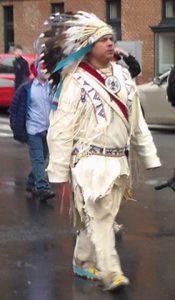Tribes March in DC for Water and for Mother Earth
On February 22, police removed Native American protestors outside the Standing Rock Sioux reservation. The protestors were trying to stop the Dakota Access Pipeline, which crosses sacred tribal ground and threatens to pollute their drinking water. With final approval at the onset of the Donald Trump presidency, the pipeline seemed inevitable.  “A lot of people were sad to see us forcibly removed at gunpoint,” says Kandi Mosset of the Mandan, Hidatsa, and Arikara nations. “We wanted to make sure fight didn’t end [so] we said we’ll go to DC,” adds Mosset, a spokeswoman for the Indigenous Environmental Network. Thus was born the Native Nations March on Washington. The march itself took place on March 10 beneath an eerie snow that turned to water at our feet, like some deity weeping frozen tears. Following a beautiful spring day, this weird weather seemed part of a changing climate. Beginning at the Army Corps of Engineers, which gave the pipeline’s final go-ahead, the march encompassed a vast column, snaking through the heart of DC. There was much whooping and beating of drums, punctuated by chants of “Water is life,” “Honor treaty rights,” and “You can’t eat oil / keep it in the soil.” Banners of various tribes, of Mother Earth, and proclaiming “I stand with Standing Rock,” punctuated the scene. The Dakota Access Pipeline is one of a host of issues highlighted by the march, although it has been in the public eye since August 2016. That was the start of an unprecedented gathering to block the pipeline, eventually swelling to over a hundred tribes, as well as supporters including U.S. military veterans. Such a gathering “hadn’t been seen in living memory,” says Dallas Goldtooth, an organizer for the Indigenous Environmental Network. The Dakota Access Pipeline is essentially complete and could be in operation “as early as next week,” says Mosset. However, she adds that “Standing Rock is still in court.” Therefore, “even if oil is flowing through the pipeline” it will stop if the tribe wins a motion for summary judgment.
“A lot of people were sad to see us forcibly removed at gunpoint,” says Kandi Mosset of the Mandan, Hidatsa, and Arikara nations. “We wanted to make sure fight didn’t end [so] we said we’ll go to DC,” adds Mosset, a spokeswoman for the Indigenous Environmental Network. Thus was born the Native Nations March on Washington. The march itself took place on March 10 beneath an eerie snow that turned to water at our feet, like some deity weeping frozen tears. Following a beautiful spring day, this weird weather seemed part of a changing climate. Beginning at the Army Corps of Engineers, which gave the pipeline’s final go-ahead, the march encompassed a vast column, snaking through the heart of DC. There was much whooping and beating of drums, punctuated by chants of “Water is life,” “Honor treaty rights,” and “You can’t eat oil / keep it in the soil.” Banners of various tribes, of Mother Earth, and proclaiming “I stand with Standing Rock,” punctuated the scene. The Dakota Access Pipeline is one of a host of issues highlighted by the march, although it has been in the public eye since August 2016. That was the start of an unprecedented gathering to block the pipeline, eventually swelling to over a hundred tribes, as well as supporters including U.S. military veterans. Such a gathering “hadn’t been seen in living memory,” says Dallas Goldtooth, an organizer for the Indigenous Environmental Network. The Dakota Access Pipeline is essentially complete and could be in operation “as early as next week,” says Mosset. However, she adds that “Standing Rock is still in court.” Therefore, “even if oil is flowing through the pipeline” it will stop if the tribe wins a motion for summary judgment.  The Dakota Access Pipeline has come to represent environmental encroachment on tribal land that has gone on for decades. Goldtooth explains, “Standing Rock is only the tip of spear.” The protests will “elevate issues beyond Standing Rock.” The overarching issue is tribal sovereignty. Environmental projects that affect tribes often pay only lip service to consultation. The tribal goal is embodied in the slogan “consent, not consultation.” Full tribal participation, as well as environmental review, is needed for every pipeline or coal mine that will affect indigenous territory. The legacy of exclusion and broken promises stretches through 500 years of European contact with the Americas. Mosset points out that, of over 450 treaties signed between different tribes and the United States, “out of all, not one has been upheld. Right now the U.S. is in violation of its own constitution.” In the case of the Standing Rock Sioux, this applies to a pair of treaties signed at Fort Laramie in 1851 and 1868.
The Dakota Access Pipeline has come to represent environmental encroachment on tribal land that has gone on for decades. Goldtooth explains, “Standing Rock is only the tip of spear.” The protests will “elevate issues beyond Standing Rock.” The overarching issue is tribal sovereignty. Environmental projects that affect tribes often pay only lip service to consultation. The tribal goal is embodied in the slogan “consent, not consultation.” Full tribal participation, as well as environmental review, is needed for every pipeline or coal mine that will affect indigenous territory. The legacy of exclusion and broken promises stretches through 500 years of European contact with the Americas. Mosset points out that, of over 450 treaties signed between different tribes and the United States, “out of all, not one has been upheld. Right now the U.S. is in violation of its own constitution.” In the case of the Standing Rock Sioux, this applies to a pair of treaties signed at Fort Laramie in 1851 and 1868.
Native nations continue to oppose fracking, drilling, and mining on a slew of fronts, particularly in the west, including the Bakken formation, Choctaw Canyon, and the Powder River Basin. “Native communities are fighting the extrajudicial leasing of federal lands to oil and gas interests,” says Goldtooth. Climate change is also at the forefront of the united tribes’ consensus. The protests are “about the fossil fuel industry all over the world, the regime that really controls government,” says Mosset. An array of speeches in front of the White House to conclude the march hammered home respect for the environment and the dangers of corporate greed. “At the beginning of time, the creator called a special and strong people to Turtle Island, the four corners of this nation,” proclaimed Fawn Sharp, President of the Quinault Indian Nation before a cheering, fist-pumping crowd. “They instructed, protect Mother Earth as you would protect your birth mother.” The speakers extolled a special duty both to one’s ancestors and to future generations, held together by environmental stewardship. “All are bound in the great web of life” said Tulsi Gabbard, representative of Hawaii and of Samoan heritage, heralding “the fight for clean water, the life blood of the planet.” Gabbard added that “Native American governance . .
. was there from the beginning of Western democracy.” Indeed, some historians credit the Iroquois Confederation as the root of U.S. democracy. Gabbard explained that “before beginning deliberations” a tribal council would “express gratitude to cousins, the earth, pools, lakes, medicinal herbs, trees, the great creator.”  The Native Nations March, however, is occurring amid gloom regarding democracy and environmental stewardship. While the Obama administration handed native activists key victories on the Keystone XL and Dakota Access pipelines, the Trump administration has reversed these. The Environmental Protection Agency, under the leadership of Scott Pruitt, is on the verge of disbanding rules protecting against climate change and ensuring clean air and water. In the face of this, says Goldtooth, it is important to “mobilize the masses to apply political pressure,” including through nonviolent civil disobedience. The Native Nations March is just one part of a long struggle. The resurgent native coalition is not acting alone. The Women’s March was just a month ago, and April will see the March for Science and the People’s Climate March in protest of Trump policies. “The struggle for women’s rights is directly connected to our struggle to protect Mother Earth,” exclaims Goldtooth.
The Native Nations March, however, is occurring amid gloom regarding democracy and environmental stewardship. While the Obama administration handed native activists key victories on the Keystone XL and Dakota Access pipelines, the Trump administration has reversed these. The Environmental Protection Agency, under the leadership of Scott Pruitt, is on the verge of disbanding rules protecting against climate change and ensuring clean air and water. In the face of this, says Goldtooth, it is important to “mobilize the masses to apply political pressure,” including through nonviolent civil disobedience. The Native Nations March is just one part of a long struggle. The resurgent native coalition is not acting alone. The Women’s March was just a month ago, and April will see the March for Science and the People’s Climate March in protest of Trump policies. “The struggle for women’s rights is directly connected to our struggle to protect Mother Earth,” exclaims Goldtooth.

